Rate-Dependent Residual Strength of Unsaturated Slip-Zone Soil Under Suction-Controlled Conditions
Abstract
1. Introduction
2. Materials
2.1. Overview of Huangtupo Landslide
2.2. Slip-Zone Soil Specimen Description
3. Methods
3.1. Soil Water Retention Characteristic Testing Methods
3.2. Suction-Controlled Ring Shear Test
3.2.1. Testing Apparatus
3.2.2. Sample Preparation and Test Procedure
- (1)
- Ceramic plate saturation: The ceramic plate was immersed in deaerated distilled water for 24 h, followed by secondary vacuum saturation for another 24 h to remove air from pores. After installation in the ring shear apparatus, deaerated distilled water was added to the water tank and 100 kPa air pressure was applied to expel free water through the ceramic plate’s micro-pores. Saturation was confirmed when water droplets appeared on the ceramic plate surface and drainage stabilized.
- (2)
- Sample installation and consolidation: Standard samples of a 25 mm thickness were used, a dimension selected to ensure a representative sample volume while maintaining a controllable drainage path length. To reduce friction, petroleum jelly was applied to the inner wall of the lower shear box, and wet filter paper was placed at the bottom to ensure water flow continuity. To ensure sample homogeneity, the soil was thoroughly mixed with de-aired distilled water, sealed in plastic wrap, and left to rest for at least 24 h to allow sufficient and uniform moisture diffusion. When installing the sample into the ring shear box, the soil was filled with three layers of equal mass. Each layer was compacted using a standard effort and its surface was roughened to enhance interlayer contact, thereby minimizing the possibility of stratification and density non-uniformity. Following installation, the sample was consolidated until stability was confirmed, defined as a vertical displacement rate of ≤0.005 mm/h.
- (3)
- Suction equilibrium: Pore air pressure was adjusted by pressurizing the main chamber to establish the desired . Suction equilibrium was achieved when the sample volume change rate was <0.035 mm/d, with each equilibrium stage taking 50–100 h.
3.2.3. Testing Program and Procedures
4. Results
4.1. SWCC
4.2. Shear Behavior During Suction-Controlled Ring Shearing
4.2.1. Shear Stress–Displacement Curve of Unsaturated Slip-Zone Soil
4.2.2. Vertical Displacement Characteristics
4.3. Unsaturated Residual Shear Strength
4.3.1. Mohr–Coulomb Strength Envelope
4.3.2. Influence of Shear Rate on Residual Strength Parameters of Slip-Zone Soil
4.3.3. Regression Model of Rate-Dependent Residual Strength Parameters
5. Discussion
6. Conclusions
- (1)
- Residual strength showed a significant increase with matric suction, with the 700 kPa condition showing higher strength than saturated conditions. Concurrently, residual strength exhibited a positive rate effect and the growth slowed at high rates ( > 50 mm/min). Crucially, residual cohesion demonstrated a significant logarithmic correlation with , with most rapid growth occurring at slow rates ( ≤ 10 mm/min), serving as the dominant factor controlling residual strength, as the residual internal friction angle varied minimally.
- (2)
- The effect of shear rate exhibited three distinct stages: In the low-rate region ( < 10 mm/min), stress decayed rapidly with early formation of a residual strength plateau, reflecting plastic flow from rapid pore water pressure dissipation and particle rearrangement. In the moderate-rate region (10–50 mm/min), larger displacement was required to achieve stability, indicating combined effects of particle orientation and pore water pressure equilibrium. In the high-speed region ( > 50 mm/min), stress–strain curves showed increased fluctuations due to the excitation–recovery cycle of instantaneous pore water pressure elevation and subsequent dissipation.
- (3)
- A robust bivariate mathematical model for residual cohesion with respect to shear rate and matric suction was established (R2 = 0.976), overcoming limitations of single-factor analysis. This model quantitatively demonstrated that the relative sensitivity of cohesion was position-dependent, precisely validating the nonlinear slope changes observed on the 3D surface. It revealed that shear rate modulation of cohesion weakened in high-suction regions ( > 200 kPa), while low-suction regions ( < 200 kPa) were more sensitive to rate changes.
Author Contributions
Funding
Data Availability Statement
Acknowledgments
Conflicts of Interest
References
- Skempton, A.W. Residual Strength of Clays in Landslides, Folded Strata and the Laboratory. Géotechnique 1985, 35, 3–18. [Google Scholar] [CrossRef]
- Bromhead, E.N. Reflections on the Residual Strength of Clay Soils, with Special Reference to Bedding-Controlled Landslides. Q. J. Eng. Geol. Hydrogeol. 2013, 46, 132–155. [Google Scholar] [CrossRef]
- Wang, G.; Suemine, A.; Schulz, W.H. Shear-Rate-Dependent Strength Control on the Dynamics of Rainfall-Triggered Landslides, Tokushima Prefecture, Japan. Earth Surf. Process. Landf. 2010, 35, 407–416. [Google Scholar] [CrossRef]
- Huang, M.L.; Sun, D.A.; Wang, C.H.; Keleta, Y. Reliability Analysis of Unsaturated Soil Slope Stability Using Spatial Random Field-Based Bayesian Method. Landslides 2021, 18, 1177–1189. [Google Scholar] [CrossRef]
- Tang, H.; Li, C.; Hu, X.; Wang, L.; Criss, R.; Su, A.; Wu, Y.; Xiong, C. Deformation Response of the Huangtupo Landslide to Rainfall and the Changing Levels of the Three Gorges Reservoir. Bull. Eng. Geol. Environ. 2015, 74, 933–942. [Google Scholar] [CrossRef]
- Fredlund, D.G. Unsaturated Soil Mechanics in Engineering Practice. J. Geotech. Geoenviron. Eng. 2006, 132, 286–321. [Google Scholar] [CrossRef]
- Kang, X.; Wang, S.; Yu, Z. Effects of Soil–Water Interaction on the Mechanical Behaviors of Shear-Zone Soils. Int. J. Geomech. 2022, 22, 06022028. [Google Scholar] [CrossRef]
- Cueva, M.; Kang, X.; Wang, S.; Soranzo, E.; Wu, W. Unveiling the Role of Saturation and Displacement Rate in the Transition from Slow Movement to Catastrophic Failure in Landslides. Eng. Geol. 2025, 352, 108042. [Google Scholar] [CrossRef]
- Hu, W.; Scaringi, G.; Xu, Q.; Van Asch, T.W.J.; Huang, R.; Han, W. Suction and Rate-Dependent Behaviour of a Shear-Zone Soil from a Landslide in a Gently-Inclined Mudstone-Sandstone Sequence in the Sichuan Basin, China. Eng. Geol. 2018, 237, 1–11. [Google Scholar] [CrossRef]
- Wang, S.; Wu, W.; Wang, J.; Yin, Z.; Cui, D.; Xiang, W. Residual-State Creep of Clastic Soil in a Reactivated Slow-Moving Landslide in the Three Gorges Reservoir Region, China. Landslides 2018, 15, 2413–2422. [Google Scholar] [CrossRef]
- Kang, X.; Wang, S.; Wu, W.; Xu, G. Residual State Rate Effects of Shear-Zone Soil Regulating Slow-to-Fast Transition of Catastrophic Landslides. Eng. Geol. 2022, 304, 106692. [Google Scholar] [CrossRef]
- Gratchev, I.B.; Sassa, K. Shear Strength of Clay at Different Shear Rates. J. Geotech. Geoenviron. Eng. 2015, 141, 06015002. [Google Scholar] [CrossRef]
- Scaringi, G.; Di Maio, C. Influence of Displacement Rate on Residual Shear Strength of Clays. Procedia Earth Planet. Sci. 2016, 16, 137–145. [Google Scholar] [CrossRef]
- Duque, J.; Loche, M.; Scaringi, G. Rate-Dependency of Residual Shear Strength of Soils: Implications for Landslide Evolution. Géotech. Lett. 2023, 13, 1–8. [Google Scholar] [CrossRef]
- Bishop, A.W.; Green, G.E.; Garga, V.K.; Andresen, A.; Brown, J.D. A New Ring Shear Apparatus and Its Application to the Measurement of Residual Strength. Géotechnique 1971, 21, 273–328. [Google Scholar] [CrossRef]
- Stark, T.D.; Vettel, J.J. Bromhead Ring Shear Test Procedure. Geotech. Test. J. 1992, 15, 24–32. [Google Scholar] [CrossRef]
- Yang, X.; Vanapalli, S.K. Mechanical Behavior of Unsaturated Soils from Suction Controlled Ring Shear Tests. Eng. Geol. 2024, 107695. [Google Scholar] [CrossRef]
- Scaringi, G.; Hu, W.; Xu, Q.; Huang, R. Shear-Rate-Dependent Behavior of Clayey Bimaterial Interfaces at Landslide Stress Levels. Geophys. Res. Lett. 2018, 45, 766–777. [Google Scholar] [CrossRef]
- Tika, T.E.; Vaughan, P.R.; Lemos, L.J.L.J. Fast Shearing of Pre-Existing Shear Zones in Soil. Géotechnique 1996, 46, 197–233. [Google Scholar] [CrossRef]
- Miao, H.; Wang, G. Shear Rate Effect on the Residual Strength of Saturated Clayey and Granular Soils under Low- to High-Rate Continuous Shearing. Eng. Geol. 2022, 308, 106821. [Google Scholar] [CrossRef]
- Xin, P.; Kang, X.; Wu, W.; Scaringi, G.; Wang, X.; Wu, Q. Centrifuge Modelling of a Roto-Translational Landslide in Stiff Clay Formation. Eng. Geol. 2025, 349, 107964. [Google Scholar] [CrossRef]
- Hu, W.; Xu, Q.; Wang, G.; Scaringi, G.; Mcsaveney, M.; Hicher, P.-Y. Shear Resistance Variations in Experimentally Sheared Mudstone Granules: A Possible Shear-Thinning and Thixotropic Mechanism. Geophys. Res. Lett. 2017, 44, 11–40. [Google Scholar] [CrossRef]
- Wang, Y.F.; Dong, J.J.; Cheng, Q.G. Velocity-Dependent Frictional Weakening of Large Rock Avalanche Basal Facies: Implications for Rock Avalanche Hypermobility? J. Geophys. Res. Solid Earth 2017, 122, 1648–1676. [Google Scholar] [CrossRef]
- Vithana, S.B.; Nakamura, S.; Gibo, S.; Yoshinaga, A.; Kimura, S. Correlation of Large Displacement Drained Shear Strength of Landslide Soils Measured by Direct Shear and Ring Shear Devices. Landslides 2012, 9, 305–314. [Google Scholar] [CrossRef]
- Kalin, M.; Jan, P. Understanding the Friction Laws of Amontons and Coulomb by Evaluating the Real Contact Area. Friction 2025, 13, 9440986. [Google Scholar] [CrossRef]
- Tang, M.; Xu, Q.; Yang, H.; Li, S.; Iqbal, J.; Fu, X.; Huang, X.; Cheng, W. Activity Law and Hydraulics Mechanism of Landslides with Different Sliding Surface and Permeability in the Three Gorges Reservoir Area, China. Eng. Geol. 2019, 260, 105212. [Google Scholar] [CrossRef]
- Gong, W.; Juang, C.H.; Wasowski, J. Geohazards and Human Settlements: Lessons Learned from Multiple Relocation Events in Badong, China—Engineering Geologist’s Perspective. Eng. Geol. 2021, 285, 106051. [Google Scholar] [CrossRef]
- Wang, J.; Su, A.; Liu, Q.; Xiang, W.; Yeh, H.-F.; Xiong, C.; Zou, Z.; Zhong, C.; Liu, J.; Cao, S. Three-Dimensional Analyses of the Sliding Surface Distribution in the Huangtupo No. 1 Riverside Sliding Mass in the Three Gorges Reservoir Area of China. Landslides 2018, 15, 1425–1435. [Google Scholar] [CrossRef]
- International Union of Geological Sciences Working Group on Landslides. A Suggested Method for Describing the Rate of Movement of a Landslide. Bull. Int. Assoc. Eng. Geol. 1995, 52, 75–78. [Google Scholar] [CrossRef]
- Zou, Z.; Luo, T.; Tan, Q.; Yan, J.; Luo, Y.; Hu, X. Dynamic Determination of Landslide Stability and Thrust Force Considering Slip Zone Evolution. Nat. Hazards 2023, 118, 31–53. [Google Scholar] [CrossRef]
- Zhang, S.; Li, Q.; Tang, H.; Zou, Z.; Zhao, J.; Zhang, J.; Wu, M. Reciprocal Rate-Modulated Evolution of Slow-Moving Reservoir Landslide: Learning from Hydrological-Adapted Block Model. Landslides 2025. [CrossRef]
- Juang, C.H. BFTS—Engineering Geologists’ Field Station to Study Reservoir Landslides. Eng. Geol. 2021, 284, 106038. [Google Scholar] [CrossRef]
- GB/T 50123-2019; Standard for Geotechnical Testing Method. China Ministry of Housing and Urban-Rural Development: Beijing, China, 2019. (In Chinese)
- Wang, S.; Wu, W.; Cui, D. On Mechanical Behaviour of Clastic Soils: Numerical Simulations and Constitutive Modelling. Geotechnique 2022, 72, 706–721. [Google Scholar] [CrossRef]
- ASTM C1699-09; Standard Test Method for Moisture Retention Curves of Porous Building Materials Using Pressure. ASTM International: West Conshohocken, PA, USA, 2009.
- ASTM E104-02; Standard Practice for Maintaining Constant Relative Humidity by Means of Aqueous Solutions. ASTM International: West Conshohocken, PA, USA, 2012.
- Miao, F.; Wu, Y.; Li, L.; Tang, H.; Xiong, F. Weakening Laws of Slip Zone Soils during Wetting–Drying Cycles Based on Fractal Theory: A Case Study in the Three Gorges Reservoir (China). Acta Geotech. 2020, 15, 1909–1923. [Google Scholar] [CrossRef]
- Van Genuchten, M.T. A Closed-form Equation for Predicting the Hydraulic Conductivity of Unsaturated Soils. Soil. Sci. Soc. Amer J. 1980, 44, 892–898. [Google Scholar] [CrossRef]
- Vanapalli, S.K.; Fredlund, D.G.; Pufahl, D.E.; Clifton, A.W. Model for the Prediction of Shear Strength with Respect to Soil Suction. Can. Geotech. J. 1996, 33, 379–392. [Google Scholar] [CrossRef]
- Hoyos, L.R.; Velosa, C.L.; Puppala, A.J. Residual Shear Strength of Unsaturated Soils via Suction-Controlled Ring Shear Testing. Eng. Geol. 2014, 172, 1–11. [Google Scholar] [CrossRef]
- Bhat, D.R.; Bhandary, N.P.; Yatabe, R. Residual-State Creep Behavior of Typical Clayey Soils. Nat. Hazards 2013, 69, 2161–2178. [Google Scholar] [CrossRef]
- Iverson, R.M. Regulation of Landslide Motion by Dilatancy and Pore Pressure Feedback. J. Geophys. Res. Earth Surf. 2005, 110, 268. [Google Scholar] [CrossRef]
- Di Maio, C. Shear Strength of Clays and Clayey Soils: The Influence of Pore Fluid Composition. In Chemo-Mechanical Couplings in Porous Media Geomechanics and Biomechanics; Loret, B., Huyghe, J.M., Eds.; Springer: Vienna, Austria, 2004; pp. 45–55. ISBN 978-3-7091-2778-0. [Google Scholar]
- Bagheri, M.; Rezania, M.; Mousavi Nezhad, M. Rate Dependency and Stress Relaxation of Unsaturated Clays. Int. J. Geomech. 2019, 19, 04019128. [Google Scholar] [CrossRef]
- Gallage, C.; Uchimura, T. Direct Shear Testing on Unsaturated Silty Soils to Investigate the Effects of Drying and Wetting on Shear Strength Parameters at Low Suction. J. Geotech. Geoenviron. Eng. 2016, 142, 04015081. [Google Scholar] [CrossRef]
- Dong, Y.; Lu, N.; Fox, P.J. Drying-Induced Consolidation in Soil. J. Geotech. Geoenviron.Eng. 2020, 146, 04020092. [Google Scholar] [CrossRef]
- Kimura, S.; Nakamura, S.; Vithana, S.B.; Sakai, K. Shearing Rate Effect on Residual Strength of Landslide Soils in the Slow Rate Range. Landslides 2014, 11, 969–979. [Google Scholar] [CrossRef]
- Leroueil, S.; Vaughan, P.R. The General and Congruent Effects of Structure in Natural Soils and Weak Rocks. Geotechnique 1990, 40, 467–488. [Google Scholar] [CrossRef]
- Urciuoli, G.; Picarelli, L.; Leroueil, S. Local Soil Failure before General Slope Failure. Geotech. Geol. Eng. 2007, 25, 103–122. [Google Scholar] [CrossRef]
- Puzrin, A.; Randolph, M. Effects of Pore Water Pressure Dissipation on Rate Dependency of Shear Strength in Localised Failure of Soils: Effects of Pore Water Pressure Dissipation. Int. J. Numer. Anal. Methods Geomech. 2015, 39, 2348. [Google Scholar] [CrossRef]
- Rempe, M.; Di Toro, G.; Mitchell, T.M.; Smith, S.A.F.; Hirose, T.; Renner, J. Influence of Effective Stress and Pore Fluid Pressure on Fault Strength and Slip Localization in Carbonate Slip Zones. J. Geophys. Res. Solid Earth 2020, 125, e2020JB019805. [Google Scholar] [CrossRef]
- Frungieri, G.; Bäbler, M.U.; Biferale, L.; Lanotte, A.S. Heavy and Light Inertial Particle Aggregates in Homogeneous Isotropic Turbulence: A Study on Breakup and Stress Statistics. Comput. Fluids 2023, 263, 105944. [Google Scholar] [CrossRef]
- Grue, R.H.; Issler, D.; L’Heureux, J.-S.; Thakur, V. Viscometric Tests of Sensitive Clay from Byneset, Norway, and Fit to the Herschel–Bulkley Model. In Landslides in Sensitive Clays: From Research to Implementation; Thakur, V., L’Heureux, J.-S., Locat, A., Eds.; Springer International Publishing: Cham, Switzerland, 2017; pp. 155–166. ISBN 978-3-319-56487-6. [Google Scholar]
- Wen, Z.; Huang, Z.; Xu, H.; Bai, Y.; Lu, J.; Liu, J. Rheological Experiments on Dense Silty Sediments under Steady Shear Loadings. Geo-Mar. Lett. 2025, 45, 9. [Google Scholar] [CrossRef]
- Aschonitis, V.G.; Gaglio, M.; Castaldelli, G.; Fano, E.A. Criticism on Elasticity-Sensitivity Coefficient for Assessing the Robustness and Sensitivity of Ecosystem Services Values. Ecosyst. Serv. 2016, 20, 66–68. [Google Scholar] [CrossRef]
- Ren, S.; Zhang, Y.; Li, J.; Wu, R.; Hao, H. Response Mechanism of the Residual Strength to the Mesostructure of the Shear Surface in the Gravelly Slip Zone of Ancient Landslides. J. Geophys. Res. Earth Surf. 2024, 129, e2023JF007605. [Google Scholar] [CrossRef]
- Guo, C.; Liu, J.; Wu, R.; Yan, Y.; Yuan, H.; Qiu, Z. Deformation and Failure Mechanisms of Deep-Seated Landslides: Insights from Guili-Baige in Jinsha River Tectonic Belt. NPJ Nat. Hazards 2025, 2, 77. [Google Scholar] [CrossRef]
- Kohler, M.; Hottiger, S.; Puzrin, A.M. Rate, Water Pressure, and Temperature Effects in Landslide Shear Zones. J. Geophys. Res. Earth Surf. 2023, 128, e2023JF007220. [Google Scholar] [CrossRef]
- Xue, C.; Wang, X.; Lian, B.; Wang, D.; Liu, K.; Luo, L.; Yang, J. Formation Mechanism of Loess-Mudstone Landslides in the Weibei Tableland Fault Active Zone of Baoji, China—Taking Wolongsi Landslide as an Example. Geomorphology 2024, 460, 109284. [Google Scholar] [CrossRef]
- Leshchinsky, B.; Olsen, M.J.; Mohney, C.; O’Banion, M.; Bunn, M.; Allan, J.; McClung, R. Quantifying the Sensitivity of Progressive Landslide Movements to Failure Geometry, Undercutting Processes and Hydrological Changes. J. Geophys. Res. Earth Surf. 2019, 124, 616–638. [Google Scholar] [CrossRef]
- Zhang, T.; Ji, J.; Liao, W.; Cui, H.; Zhang, W. Seismically Progressive Motion Mechanism of Earth Slopes Considering Shear Band Porewater Pressure Feedback under Earthquake Excitations. Comput. Geotech. 2024, 165, 105909. [Google Scholar] [CrossRef]
- Su, X.; Wu, W.; Tang, H.; Huang, L.; Xia, D.; Lu, S. Physicochemical Effect on Soil in Sliding Zone of Reservoir Landslides. Eng. Geol. 2023, 324, 107249. [Google Scholar] [CrossRef]
- Wu, M.; Zhang, G.; Zhang, S.; Huang, W.; Zou, H. Spatiotemporal Decoupling of Rainfall Patterns and Shallow Landslide Stability: Lessons Learned from Calibrated Ensemble Physically-Based Models. J. Rock Mech. Geotech. Eng. 2025; in press. [Google Scholar] [CrossRef]
- Zhang, S.; Li, Q.; Yuan, J.; Mao, Y.; Xu, L.; Zhang, C.; Qin, L.; Chen, H. Evaluating Risk in Reservoir Accumulation Landslides: The Role of Instability Pattern Uncertainty. Q. J. Eng. Geol. Hydrogeol. 2025, 58, qjegh2024-138. [Google Scholar] [CrossRef]
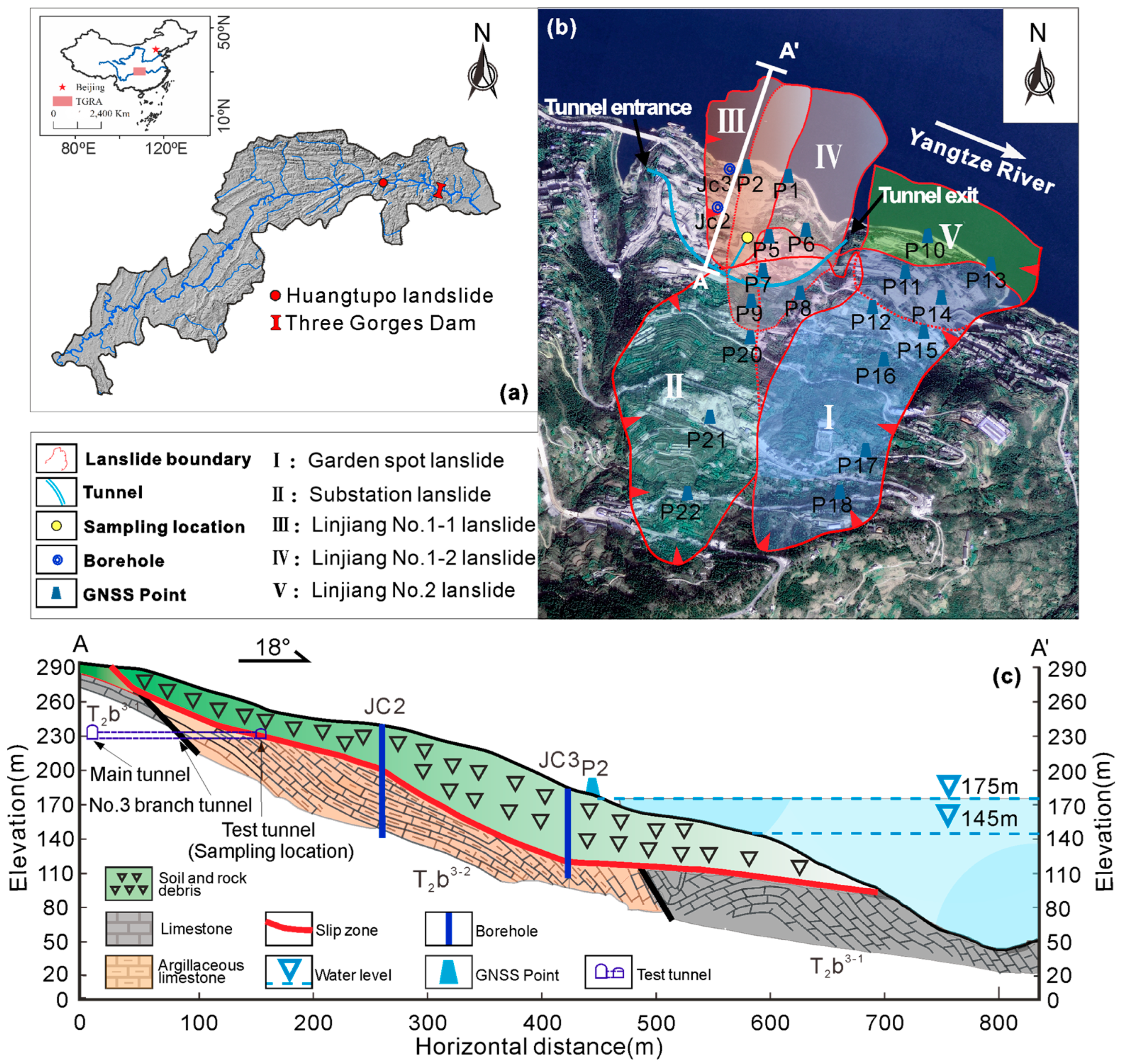
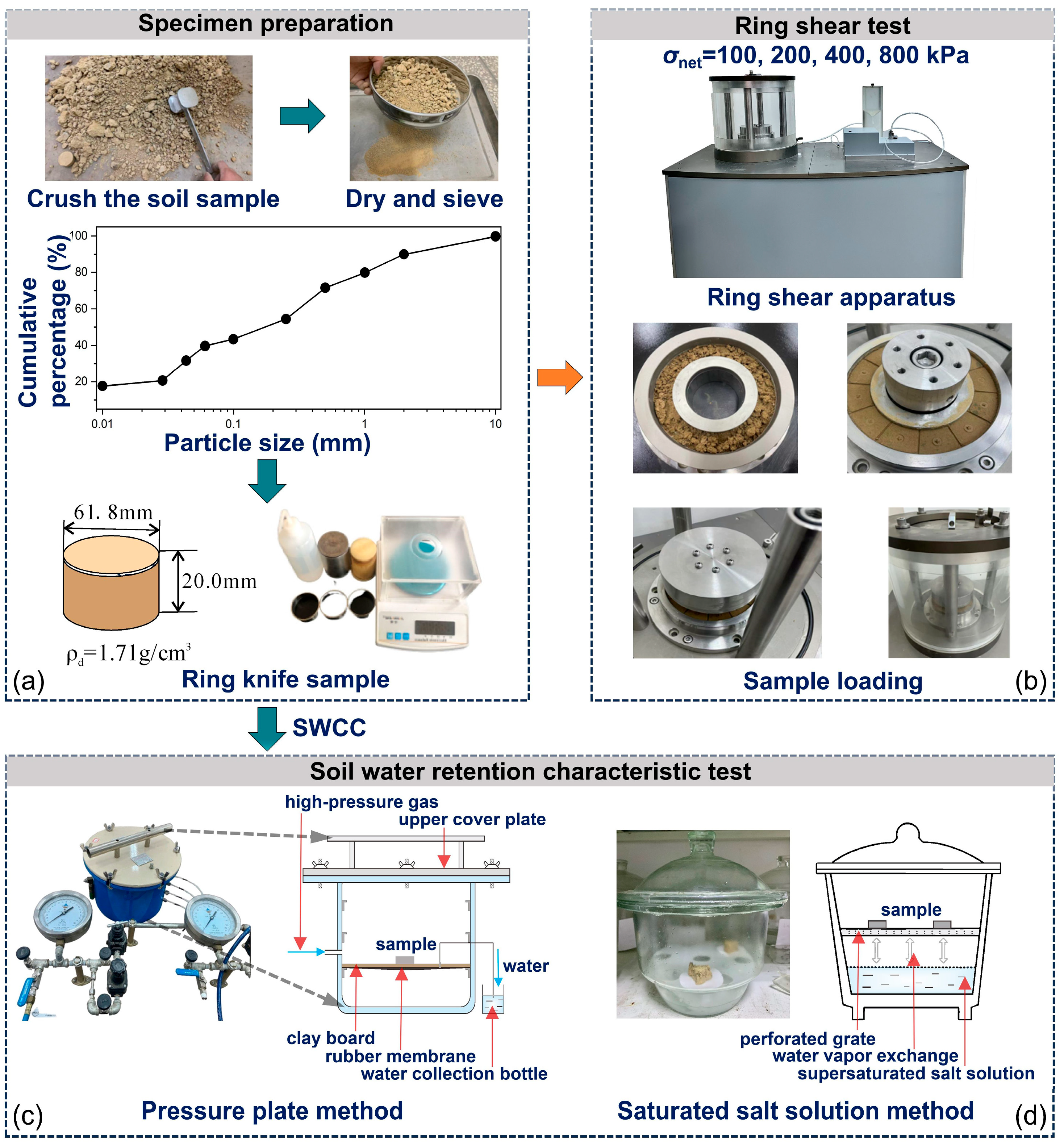
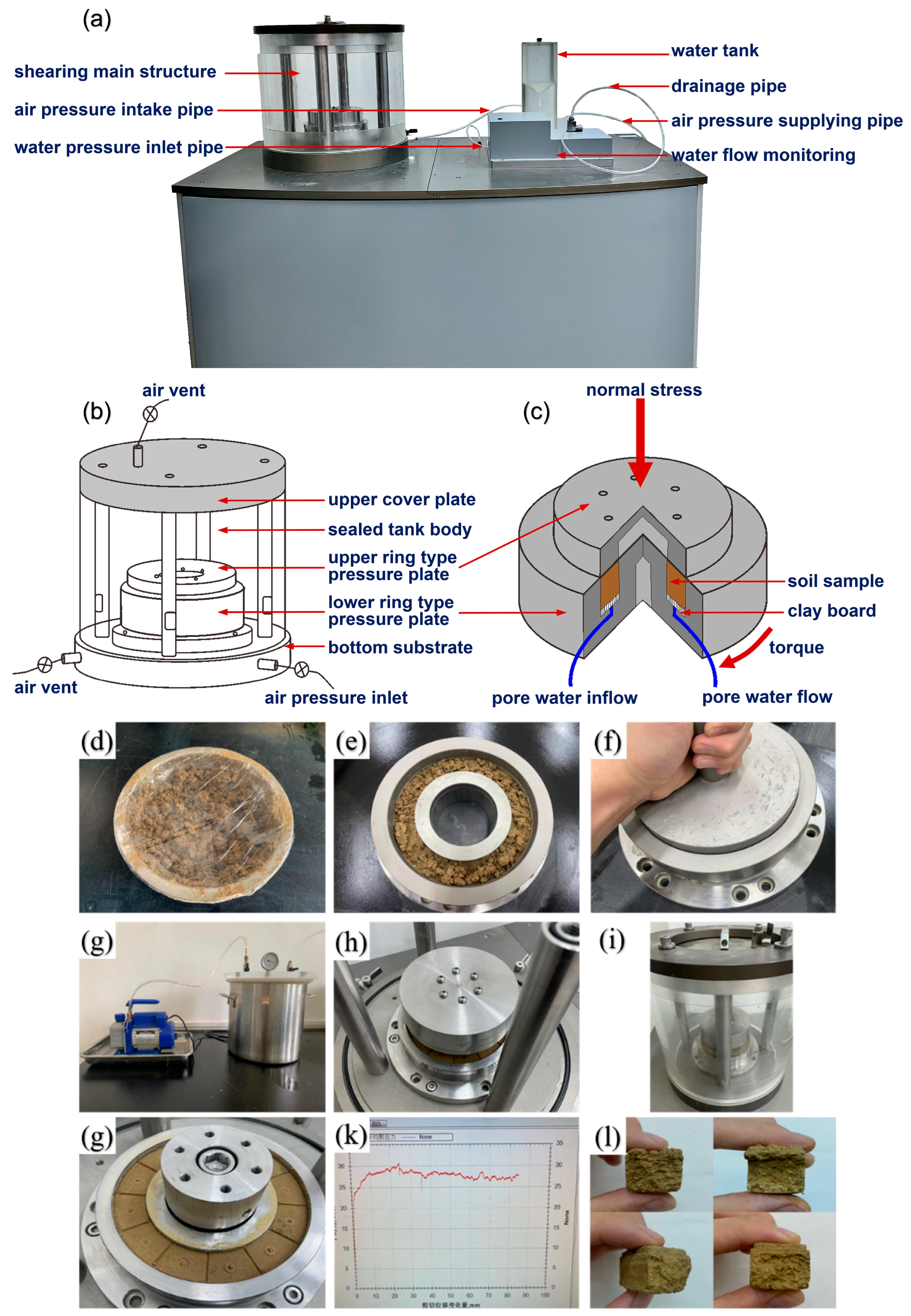
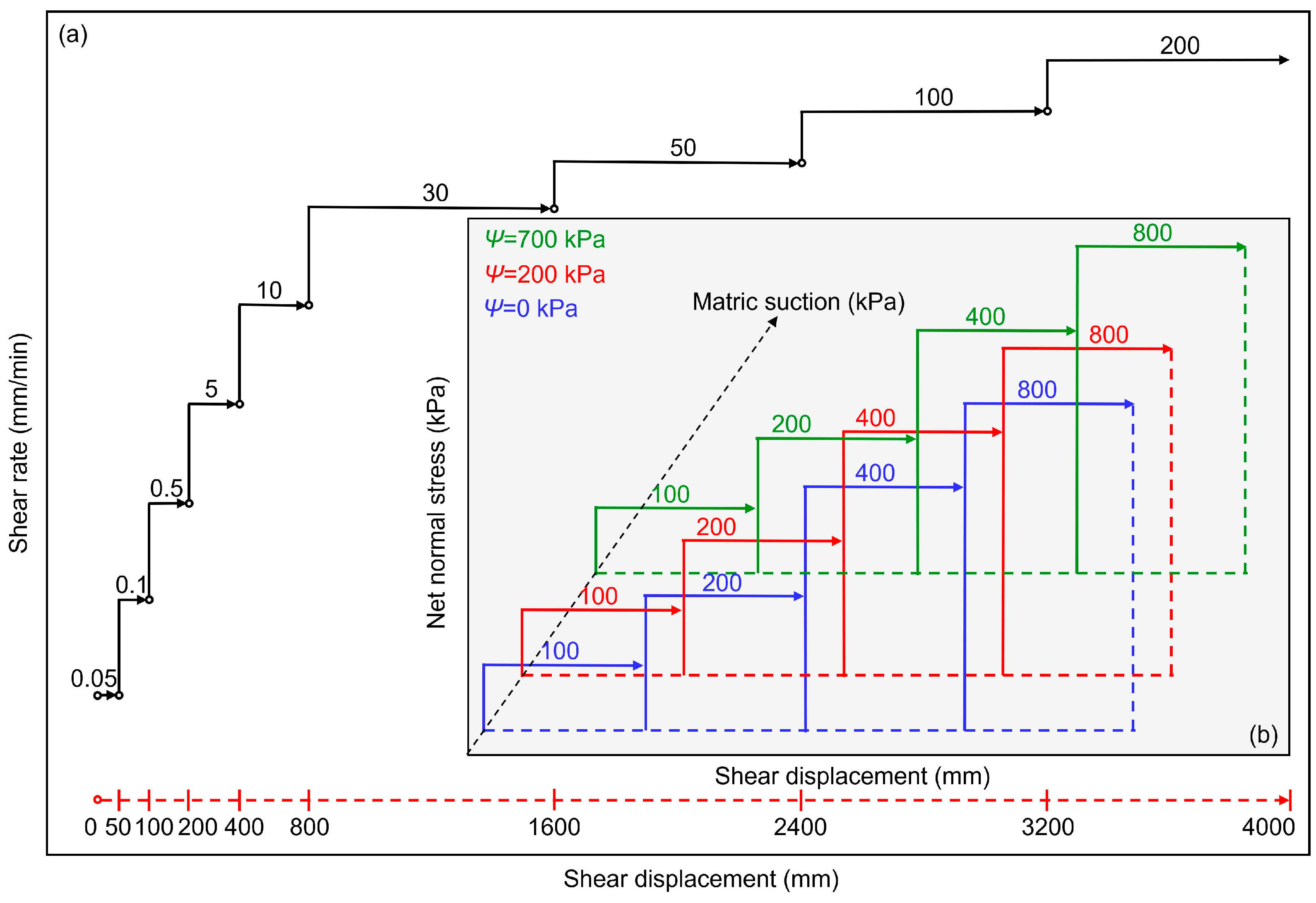
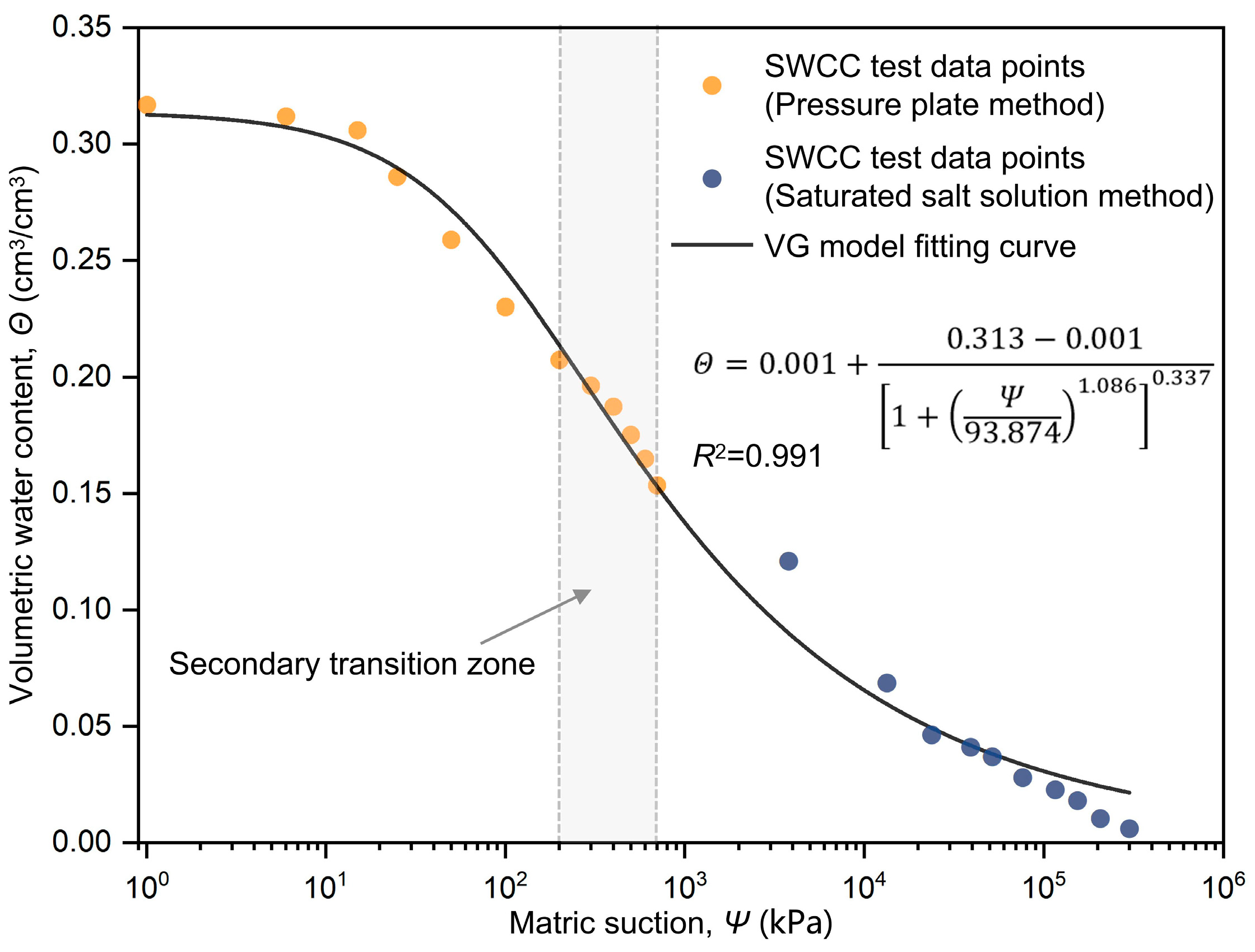
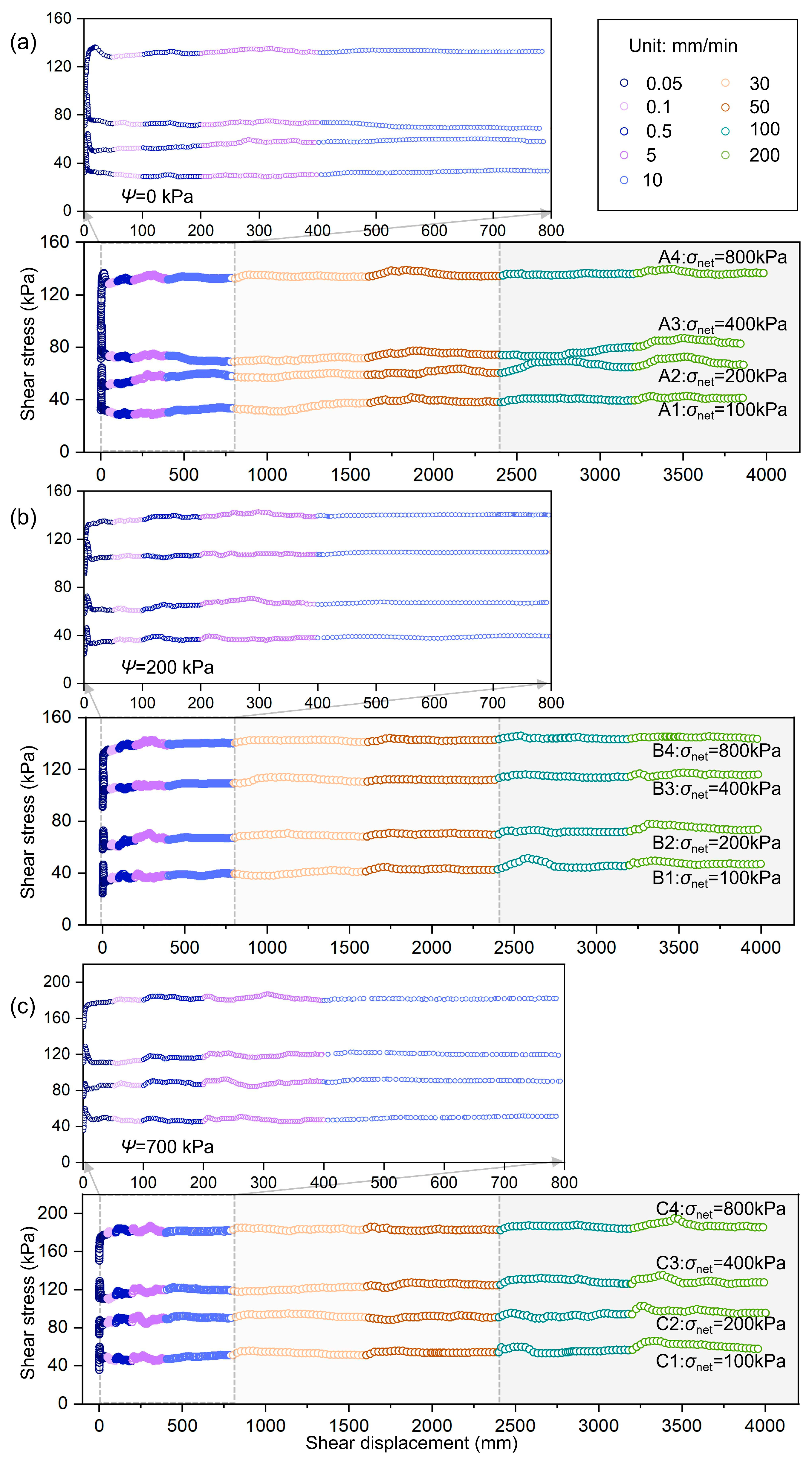
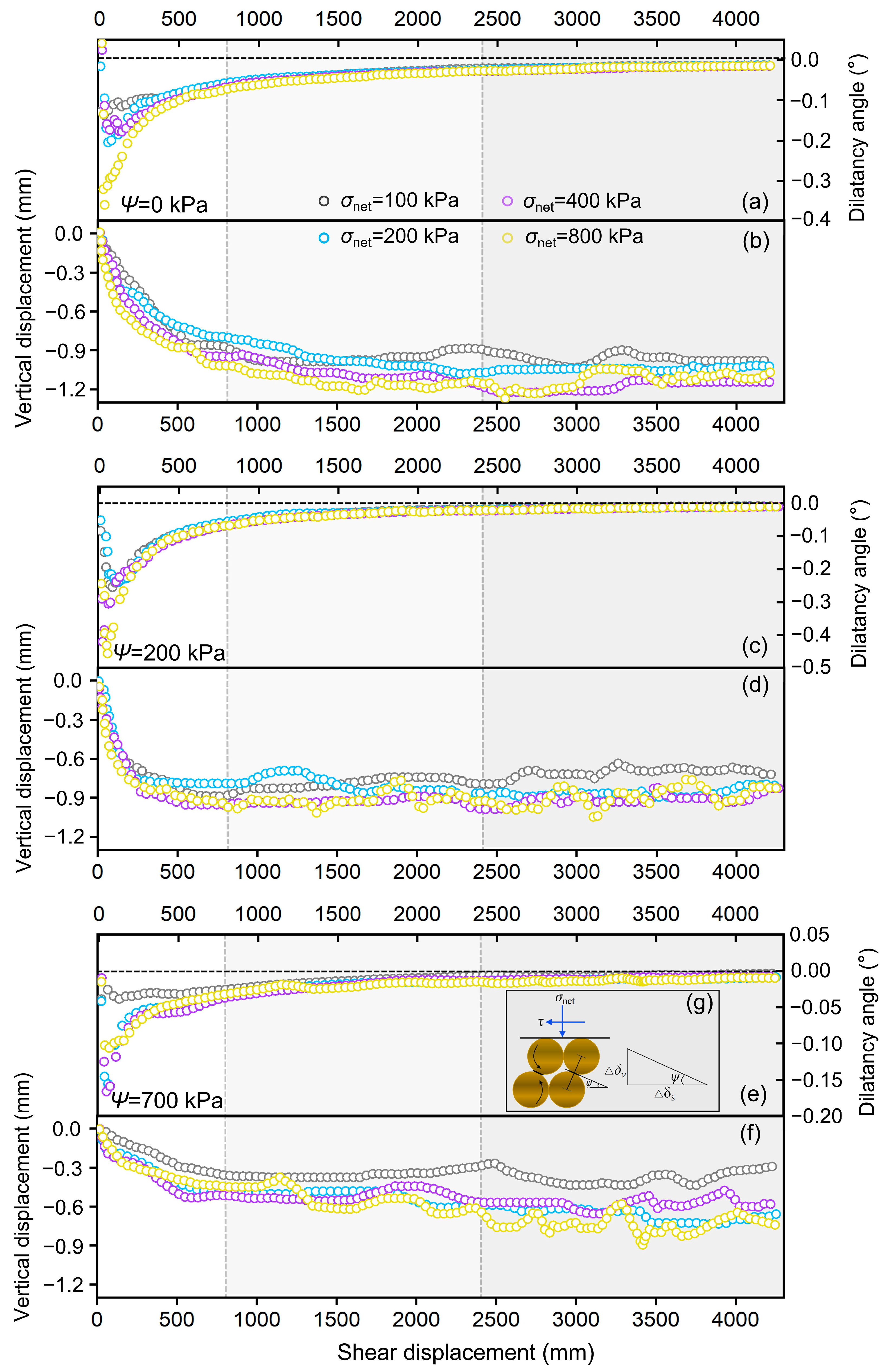
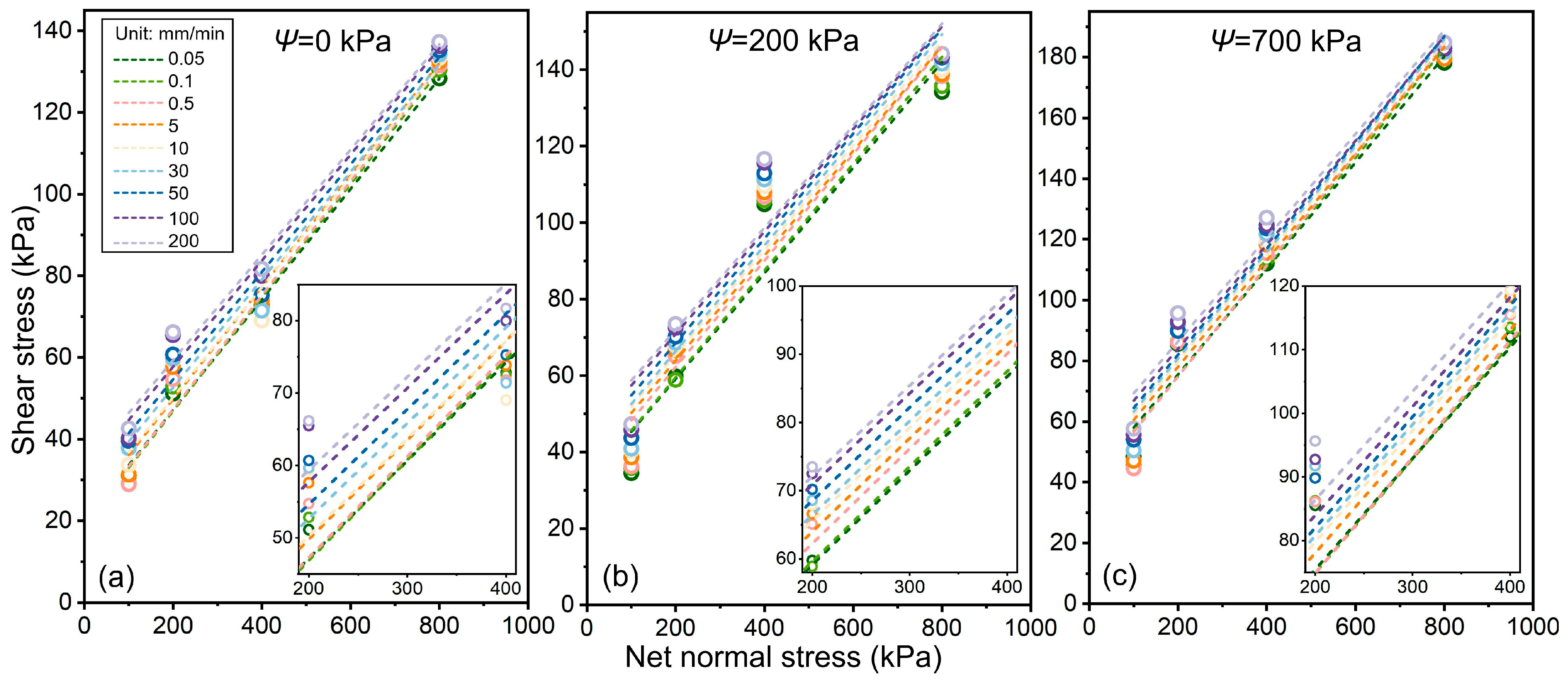

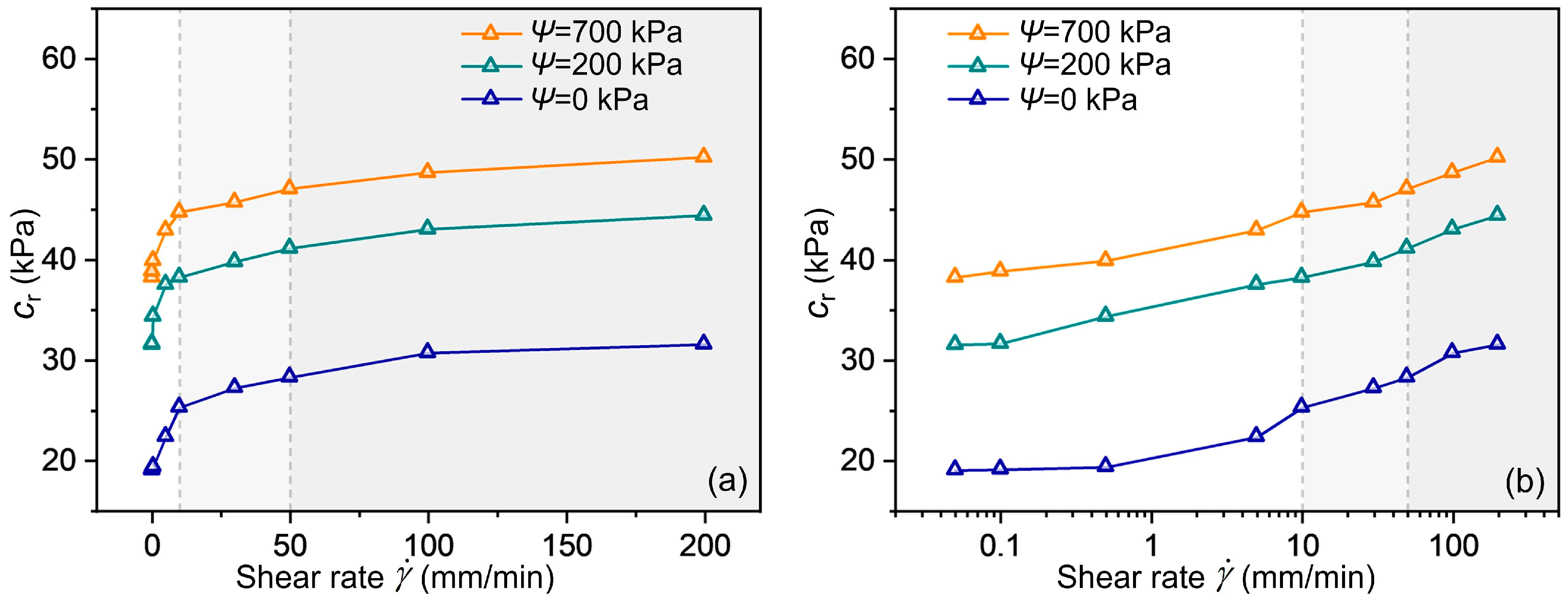
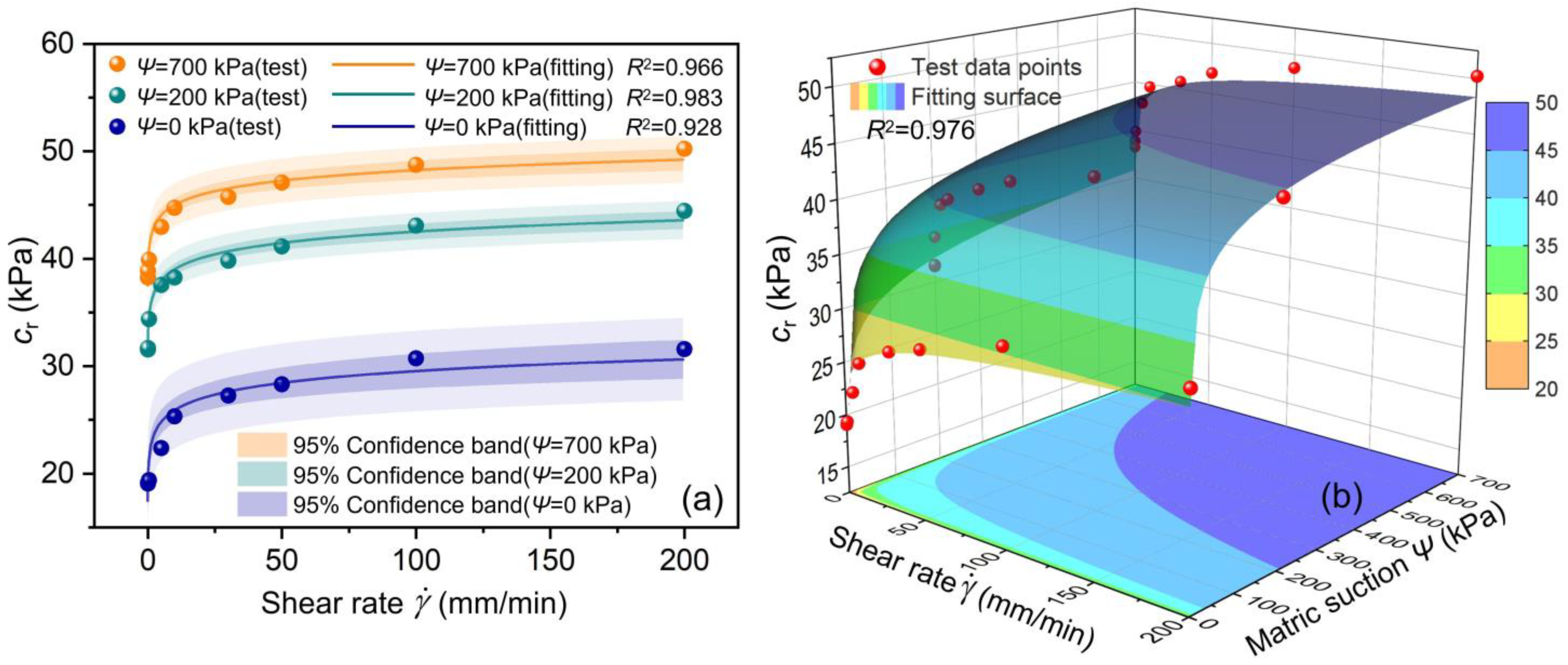
| Property | Indices, Symbol (Unit) | Value |
|---|---|---|
| Physical parameters | (g·cm−3) | 2.01 |
| (g·cm−3) | 2.06 | |
| Natural water content, ωn (%) | 12.03 | |
| Saturated water content, ωs (%) | 20.77 | |
| (g·cm−3) | 1.69 | |
| Void ratio, e | 0.58 | |
| Specific gravity, Gs | 2.68 | |
| Liquid limit, ωL (%) | 29.90 | |
| Plastic limit, ωP (%) | 12.30 | |
| Plastic index, Ip (%) | 17.60 | |
| Saturated hydraulic conductivity, Ks (cm/s) | 2.33 × 10−6 | |
| Consolidation parameters | Coefficient of consolidation, Cv (m2/s) | 7.98 × 10−8 |
| Mineral composition | Quartz (%) | 20.8–24.4 |
| K-feldspar (%) | 0–4.2 | |
| Dolomite (%) | 0~5 | |
| Calcite (%) | 19.5–20.8 | |
| Clay mineral (%) | 52.0–53.5 | |
| Montmorillonite (%) | 6.7–12.9 | |
| Illite (%) | 40.6–45.3 |
| Saturated Salt Solution | Relative Humidity/% | RH Uncertainty (±%) | Total Suction/MPa | Suction Uncertainty (±MPa) |
|---|---|---|---|---|
| LiCl·H2O | 11.3 | 0.3 | 300.02 | 15 |
| CH3COOK | 22.5 | 0.3 | 205.19 | 10 |
| MgCl2·6H2O | 32.8 | 0.2 | 153.47 | 7 |
| K2CO3 | 43.2 | 0.4 | 115.62 | 8 |
| NaBr | 57.6 | 0.4 | 75.91 | 5 |
| KI | 68.9 | 0.3 | 51.26 | 4 |
| NaCl | 75.3 | 0.1 | 39.04 | 2 |
| KCl | 84.2 | 0.3 | 23.66 | 1.5 |
| Na2SO3·10H2O | 90.8 | 0.8 | 13.28 | 2 |
| K2SO4 | 97.3 | 0.5 | 3.77 | 0.5 |
| Test No. | , kPa) | Matric Suction , kPa) | Shear Rate , mm/min) | |
|---|---|---|---|---|
| A | A1 | 100 | 0 | 0.05, 0.1, 0.5, 5, 10, 30, 50, 100, 200 |
| A2 | 200 | |||
| A3 | 400 | |||
| A4 | 800 | |||
| B | B1 | 100 | 200 | |
| B2 | 200 | |||
| B3 | 400 | |||
| B4 | 800 | |||
| C | C1 | 100 | 700 | |
| C2 | 200 | |||
| C3 | 400 | |||
| C4 | 800 | |||
| kPa) | (kPa) | Index | , kPa) | ||||||||
|---|---|---|---|---|---|---|---|---|---|---|---|
| 0.05 | 0.1 | 0.5 | 5 | 10 | 30 | 50 | 100 | 200 | |||
| 0 | 100 | (kPa) | 31.1 | 29.1 | 28.9 | 31.3 | 33.7 | 37.8 | 39.5 | 40.2 | 42.6 |
| 200 | 51.1 | 52.8 | 54.7 | 57.6 | 59.3 | 59.7 | 60.7 | 65.5 | 66.2 | ||
| 400 | 72.9 | 72.5 | 71.8 | 73.9 | 69.0 | 71.4 | 75.3 | 80.0 | 81.7 | ||
| 800 | 128.3 | 130.4 | 131.5 | 132.4 | 133.4 | 134.1 | 135.2 | 136.2 | 137.2 | ||
| / | (kPa) | 19.07 | 19.12 | 19.38 | 22.37 | 25.32 | 27.25 | 28.31 | 30.72 | 31.57 | |
| (°) | 7.69 | 7.92 | 7.95 | 7.81 | 7.67 | 7.52 | 7.49 | 7.41 | 7.35 | ||
| 0.99 | 0.98 | 0.98 | 0.97 | 0.95 | 0.97 | 0.98 | 0.97 | 0.98 | |||
| 200 | 100 | (kPa) | 34.5 | 35.8 | 36.3 | 38.6 | 40.4 | 40.9 | 43.7 | 45.8 | 47.3 |
| 200 | 59.8 | 58.9 | 65.1 | 66.6 | 67.9 | 68.6 | 70.2 | 72.5 | 73.5 | ||
| 400 | 104.8 | 105.8 | 106.8 | 107.9 | 109.6 | 111.3 | 112.9 | 115.7 | 116.7 | ||
| 800 | 134.2 | 135.7 | 138.3 | 138.8 | 140.1 | 141.6 | 143.2 | 143.4 | 144.2 | ||
| / | (kPa) | 31.54 | 31.66 | 34.36 | 37.56 | 38.25 | 39.80 | 41.13 | 43.06 | 44.43 | |
| (°) | 7.86 | 7.95 | 7.93 | 7.81 | 7.78 | 7.86 | 7.80 | 7.63 | 7.59 | ||
| 0.87 | 0.88 | 0.88 | 0.88 | 0.88 | 0.87 | 0.88 | 0.86 | 0.86 | |||
| 400 | 100 | (kPa) | 48.4 | 45.6 | 44.6 | 47.1 | 50.4 | 50.5 | 54.0 | 55.6 | 57.7 |
| 200 | 85.6 | 86.3 | 86.1 | 90.3 | 90.6 | 91.8 | 89.9 | 92.8 | 95.7 | ||
| 400 | 112.0 | 113.5 | 115.5 | 118.3 | 119.3 | 121.7 | 123.6 | 124.7 | 127.1 | ||
| 800 | 178.2 | 180.2 | 181.4 | 179.4 | 181.5 | 181.8 | 182.9 | 182.8 | 184.8 | ||
| / | (kPa) | 38.24 | 38.87 | 39.91 | 42.94 | 44.73 | 45.74 | 47.07 | 48.71 | 50.23 | |
| (°) | 9.91 | 10.21 | 10.37 | 9.96 | 9.94 | 9.93 | 9.91 | 9.72 | 9.69 | ||
| 0.97 | 0.96 | 0.96 | 0.94 | 0.95 | 0.94 | 0.96 | 0.96 | 0.95 | |||
| /kPa | A | B | R2 |
|---|---|---|---|
| 0 | 1.590 | 22.115 | 0.928 |
| 200 | 1.533 | 35.399 | 0.983 |
| 700 | 1.415 | 41.671 | 0.966 |
Disclaimer/Publisher’s Note: The statements, opinions and data contained in all publications are solely those of the individual author(s) and contributor(s) and not of MDPI and/or the editor(s). MDPI and/or the editor(s) disclaim responsibility for any injury to people or property resulting from any ideas, methods, instructions or products referred to in the content. |
© 2025 by the authors. Licensee MDPI, Basel, Switzerland. This article is an open access article distributed under the terms and conditions of the Creative Commons Attribution (CC BY) license (https://creativecommons.org/licenses/by/4.0/).
Share and Cite
Yuan, J.; Zhu, R.; Mao, Y.; Xu, L.; Zhao, J.; Zhang, C.; Zhang, S. Rate-Dependent Residual Strength of Unsaturated Slip-Zone Soil Under Suction-Controlled Conditions. Geosciences 2025, 15, 397. https://doi.org/10.3390/geosciences15100397
Yuan J, Zhu R, Mao Y, Xu L, Zhao J, Zhang C, Zhang S. Rate-Dependent Residual Strength of Unsaturated Slip-Zone Soil Under Suction-Controlled Conditions. Geosciences. 2025; 15(10):397. https://doi.org/10.3390/geosciences15100397
Chicago/Turabian StyleYuan, Jin, Rui Zhu, Yanpian Mao, Lanlan Xu, Jianfan Zhao, Chao Zhang, and Shu Zhang. 2025. "Rate-Dependent Residual Strength of Unsaturated Slip-Zone Soil Under Suction-Controlled Conditions" Geosciences 15, no. 10: 397. https://doi.org/10.3390/geosciences15100397
APA StyleYuan, J., Zhu, R., Mao, Y., Xu, L., Zhao, J., Zhang, C., & Zhang, S. (2025). Rate-Dependent Residual Strength of Unsaturated Slip-Zone Soil Under Suction-Controlled Conditions. Geosciences, 15(10), 397. https://doi.org/10.3390/geosciences15100397







